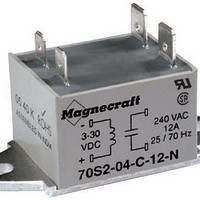70S2-04-B-12-N Magnecraft / Schneider Electric, 70S2-04-B-12-N Datasheet - Page 24

70S2-04-B-12-N
Manufacturer Part Number
70S2-04-B-12-N
Description
Solid State Relays 140VAC, 30VDC, 12A 30V PM SSR
Manufacturer
Magnecraft / Schneider Electric
Datasheets
1.70S2-04-B-12-N.pdf
(3 pages)
2.70S2-01-A-05-N.pdf
(32 pages)
3.70S2-04-D-03-V.pdf
(22 pages)
Specifications of 70S2-04-B-12-N
Control Voltage Range
3 VDC to 30 VDC
Load Voltage Rating
24 VAC to 140 VAC
Load Current Rating
12 A
Output Device
Triac
Mounting Style
Panel
Operating Voltage Range
24VAC To 140VAC
Load Current
12A
Isolation Voltage
4000VAC
Control Voltage Type
DC
Relay Terminals
Blade
Load Voltage Max
140VAC
Brand/series
70S2 Series
Contact Form
SPST-NO
Current, Rating
12 A
Dielectric Strength
3000 V (RMS)
Function
Zero-Switching
Mounting Type
Panel
Relay Type
Solid State
Standards
UL, CSA
Termination
Screw
Voltage, Control
30 VDC
Voltage, Rating
140 VAC
Lead Free Status / RoHS Status
Lead free / RoHS Compliant
Lead Free Status / RoHS Status
Lead free / RoHS Compliant, Lead free / RoHS Compliant
Application Data
24
Magnecraft
Definition
A solid state relay (SSR) can perform many tasks that an electromechanical relay
(EMR) can perform� The SSR differs in that it has no moving mechanical parts� It is
essentially an electronic device that relies on the electrical and optical properties of
semiconductors to achieve its isolation and switching function�
Principle of Operation
SSRs are similar to electromechanical relays, in that both use a control circuit and a
separate circuit for switching the load� When voltage is applied to the input of the SSR,
the relay is energized by a light emitting diode� The light from the diode is beamed
into a light sensitive semiconductor which conditions the control circuit to turn on the
output solid state switch� In the case of zero voltage crossover relays, the output solid
state switch is turned on at the zero crossing of AC voltage� Removal of the input
power disables the control circuit and the solid state switch also turns off when the
load current passes through the zero point of its cycle� Zero cross is only applied to AC
switching circuits� DC switching circuits operate at an instant on/off rate�
Advantages
When used correctly in the intended application, the SSR provides many of the
characteristics that are often difficult to find in the EMR: a high degree of reliability,
long service life, significantly reduced electromagnetic interference, fast response
and high vibration resistance are significant benefits of the SSR� The SSR has
no moving parts to wear out or arcing contacts to deteriorate, which are often the
primary cause of failure with an EMR�
„
„
„
„
„
Long life (reliability) > 1E+9 operations
Zero voltage turn on, low EMI/RFI
Shock and vibration resistant
Random turn-on, proportional control
No contact bounce
EMR vs SSR Technology
EMR
SSR
LED
CURRENT
LIMITER
ARMATURE
COIL
®
PHOTODETECTOR
Solid State Relays
COUPLING
OPTICAL
MAGNETIC
COUPLING
„
„
„
„
„
Arc-less switching
No acoustical noise
TTL compatible
Fast response
No moving parts
TRIGGER
MECHANICAL
CONTACTS
OUTPUT
DEVICE
(SSR)




















